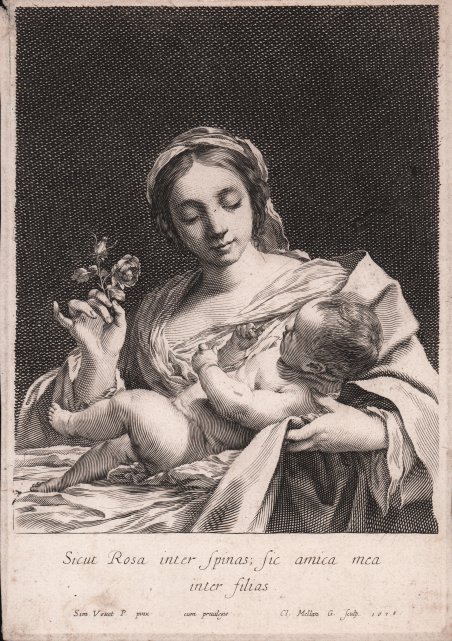Dettagli
Anno di pubblicazione
1638
Descrizione
La Vergine tiene il Bambino sul braccio sinistro e una rosa nella mano destra. Bulino, 1638, con iscrizione in latino, data e nomi del disegnatore e dell'incisore; in basso "Sicut Rosa inter spinas .". Sim Vouet P pinx cum privilegio Cl. Mellan G. Sculp 1638". Da un disegno di Simon Vouet. Bella impressione, stampata su carta vergata coeva, con margini sottili, in buono stato di conservazione. Claude Mellan e il suo caratteristico stile incisorio erano molto apprezzati dagli intenditori parigini del XVII secolo. Sebbene inizi con una formazione come pittore, la maggior parte della sua opera consiste, tuttavia, in disegni e circa 400 stampe - ritratti, soggetti religiosi e illustrazioni - derivanti da suoi disegni e da quelli di altri artisti. Molto importante per l’artista fu il suo periodo romano; Mellan viaggiò a Roma nel 1624, con l'intenzione di studiare con il talentuoso incisore Francesco Villamena, che purtroppo morì poco dopo il suo arrivo. Tuttavia, nella loro dipendenza dal tratteggio parallelo per modellare le forme e suggerire i valori tonali, le stampe italiane di Mellan riflettono il lavoro altamente sistematico di Villamena. Anche l'influenza di Simon Vouet fu duratura; entrambi gli artisti vivevano nella stessa casa a Roma e, in Mellan, Vouet trovò una mano comprensiva per riprodurre i suoi disegni. In cambio, aiutò Mellan con ritratti dal vero che usavano gessetti neri e rossi alla maniera italiana di Federico Zuccari e Ottavio Leoni. Bibliografia IFF / Inventaire du Fonds Français: Bibliothèque Nationale, Département des Estampes (10.II); Montaiglon 1856 / Catalogue raisonné de l'oeuvre de Claude Mellan (10); Le Blanc 1854-1890., S. III.3.21. The Virgin holding the Christ Child on her left arm and a rose in her right hand. Engraving, 1638, lettered with inscription in Latin, date and names of designer and engraver; along bottom 'Sicut Rosa inter spinas . Sim Vouet P pinx cum privilegio Cl. Mellan G. Sculp 1638.' After Simon Vouet. A fine impression, printed on contemporary laid paper, with thin margins, good condition. Claude Mellan and his distinctive engraving style were highly prized by 17th-century Parisian connoisseurs. Although he began with training as a painter, however, most of his work consists of drawings and some 400 prints-portraits, religious subjects, and illustrations-derived from his own drawings and those of other artists. Very important for the artist was his Roman period; Mellan traveled to Rome in 1624, intending to study with the talented engraver Francesco Villamena, who unfortunately died shortly after his arrival. However, in their reliance on parallel hatching to model forms and suggest tonal values, Mellan's Italian prints reflect Villamena's highly systematic work. Simon Vouet's influence was also enduring; both artists lived in the same house in Rome, and in Mellan, Vouet found an understanding hand to reproduce his drawings. In return, he helped Mellan with portraits from life that used black and red chalks in the Italian manner of Federico Zuccari and Ottavio Leoni. Bibliografia IFF / Inventaire du Fonds Français: Bibliothèque Nationale, Département des Estampes (10.II); Montaiglon 1856 / Catalogue raisonné de l'oeuvre de Claude Mellan (10); Le Blanc 1854-1890., S. III.3.21. Cfr.

Scopri come utilizzare
Scopri come utilizzare

